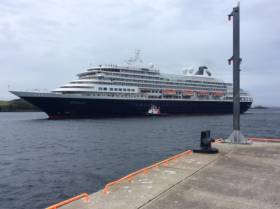Displaying items by tag: CruiseWales
Cunard Head to Holyhead, Anglesey this Summer as Cruise Tourism Becomes 'Big Business' in Wales
Cruisecalls among them from Cunard Line is to visit the Port of Holyhead, Anglesey this summer as the tourism sector booms in Wales.
This year the country is due to welcome a record 91 cruiseships to date, with Holyhead port leading the way with more than half of the total calling to the port.
Across the Irish Sea, as Afloat reported Dun Laoghaire Harbour (alone is to pip the Welsh national total) with 92 cruise visits booked this season so far to visit the Irish harbour, though no 'Cunarders' are scheduled to call this year.
Holyhead, however will have the prestigious MS Queen Victoria which is scheduled to dock on 4 June, its first call at the deep water jetty (acquired, see story) under Stena Line’s ownership. The Vista class 16-deck ship, is likened to a sea liner because of its interior decor, and the Italian built cruiseship (a sister of Queen Elizabeth), is capable of carrying almost 2,100 passengers as well as 900 crew.
The “cruise is big business in Wales” and this is where the Welsh Government has been working with Cruise Wales – a partnership between the country’s six cruise ports. Asides Holyhead, Afloat adds all these ports are all in south Wales, they are Fishguard, Pembroke Dock (Milford Haven), Swansea, Cardiff and Newport.
To promote the sector, Cruise Wales is develop new onshore tour itineraries for passengers and also to showcase the nation’s attractions. Examples of these new breed of itineraries include the themes of ‘Coal, Coin and Cheers’ with tours throughout south Wales.
In total this year Wales is to see 80,000 passengers and 39,000 crew, this equates to a potential passenger day spend income of £8.3 million.
The first call of the 2023 season to Holyhead will be Viking Venus on 6 April and on the same day Spitzbergen is scheduled to visit Fishguard.
Holyhead is to welcome more than half the nation’s total with 53 calls.
The call by Viking Venus is to take place following a visit to Dun Laoghaire Harbour which opens the season for the Irish port and this will involve an anchorage call.
More from NorthWalesLive here.
#cruiseliners - The cruiseship MS Prinsendam which featured on RTE's The Local Eye, will call at Milford Haven, south Wales this weekend as part of a 14-night Irish and Scottish Explorer Cruise from Amsterdam.
The 37,000 gross tonnage ship is due to arrive from Belfast at 08:00 on Sunday 13th August when over 800 passengers and crew will be offered complimentary entry into Milford Museum and a free shuttle bus around the town. A number of excursions will take passengers to the popular Pembrokeshire destinations of Tenby, Carew, St Davids and Pembroke Castle, as well as the National Botanic Garden of Wales in Carmarthenshire.
Prinsendam belongs to the Holland America Line fleet and according to the Port of Milford Haven she last visited the port in 2015. She was due to call in June but was forced to cancel due to poor weather conditions.
The port in Pembrokeshire is expecting two more cruise calls this year – Ocean Majesty is due on 16th September, shortly followed by the Europa on 21st September which is one of the only six star cruise ships in the world. Back in June, the Port welcomed the Silver Explorer to Pembroke as part of its eleven day ‘Anglo-Celtic Islands in Spring’ tour.
Alec Don, Chief Executive at the Port of Milford Haven, said “Cruise calls are a highlight in our events calendar and the whole community enjoys seeing the vast vessels in the Milford Haven Waterway. As well as the pre-arranged trips to some of Pembrokeshire’s fantastic attractions, we hope many passengers and crew members will enjoy spending time in Milford Haven and sample the excellent range of shops, cafes and activities on offer around the waterfront and in the town centre.”





























































